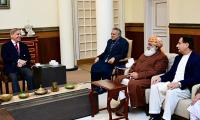Islamabad: Pakistan is confronting a major education crisis, with 25.3 million children aged 5-16 out of school, representing 36% of the school-age population in the country, according to a report by the Pak Alliance for Maths and Science.
The report, titled “The Missing Third of Pakistan ,” offered the first comprehensive analysis of out-of-school children at the tehsil level with the help of data from the 2023 population census. It revealed stark inequalities in educational access, particularly in rural regions, and underscored the necessity for targeted interventions and systemic reforms to provide equal educational opportunities nationwide. The findings presented a grim overview of Pakistan’s educational landscape, revealing that 74% of out-of-school children live in rural areas. Efforts to boost enrolment in these regions encounter substantial obstacles, including limited access to schools, poverty, and various social barriers.
The education divide between rural and urban areas is expanding, with 18.8 million out-of-school children residing solely in rural communities. Particularly vulnerable are children aged 5-9, with 51 per cent of this age group never having enrolled in school. Even more troubling is the fact that over half of these children have either dropped out or are no longer attending school.
Such early educational setbacks are likely to have enduring effects on literacy rates, as foundational skills are typically acquired during these formative years. Enrolment delays pose a significant issue, especially in rural areas, where economic constraints and inadequate infrastructure hinder many children from entering classrooms. Gender disparity exacerbates this crisis further.
The report indicated that 53 per cent of the out-of-school population consisted of girls, with the situation being especially dire in rural areas where female literacy rates were already low. In certain tehsils, over 80 per cent of girls aged 5-16 have never attended school, highlighting entrenched gender inequality in educational access. The report showed the gap in educational attainment between boys and girls was widening due to cultural and socioeconomic factors that often restricted girls from pursuing education.
It added that even urban areas, typically better equipped with educational resources, were not immune to the problem. Major cities like Karachi and Lahore still have significant numbers of out-of-school children, with Karachi alone having nearly 1.8 million children not enrolled in school, underscoring the severity of the crisis. The report emphasised the urgent need for a data-driven strategy to tackle Pakistan’s profound educational deficits.
It advocated for targeted interventions, particularly in tehsils with the highest concentrations of out-of-school children, to close the educational gap between rural and urban regions. Moreover, the report stressed the necessity for collaboration between federal and provincial governments to address these disparities, urging them to prioritise the development of infrastructure that can accommodate a higher enrolment. It warned that without prompt action, the situation could worsen, jeopardising the country’s future workforce and economic development.
A group photo of students of the IMCG Margalla, F-7/4 at a seminar on Human Solidarity on December 20, 2024. —...
A man tries to clear snow off a vehicle on a road in Murree. — AFP/FileRawalpindi:City Traffic Police Murree has...
In this image Senator Captain Shaheen Khalid Butt assumes a role as the Managing Director of Pakistan Bait-ul-Mal ...
Students of Model College i8/4 along with Principal Prof Shugufta Naz seeing stars through the telescope in a...
Moroccan Ambassador to Pakistan Mohammad Karmoun looks right as he speaks in a meeting....
The Greek Navy conducts a rescue operation after a migrant boat capsized off the island of Gavdos, Greece, December...







